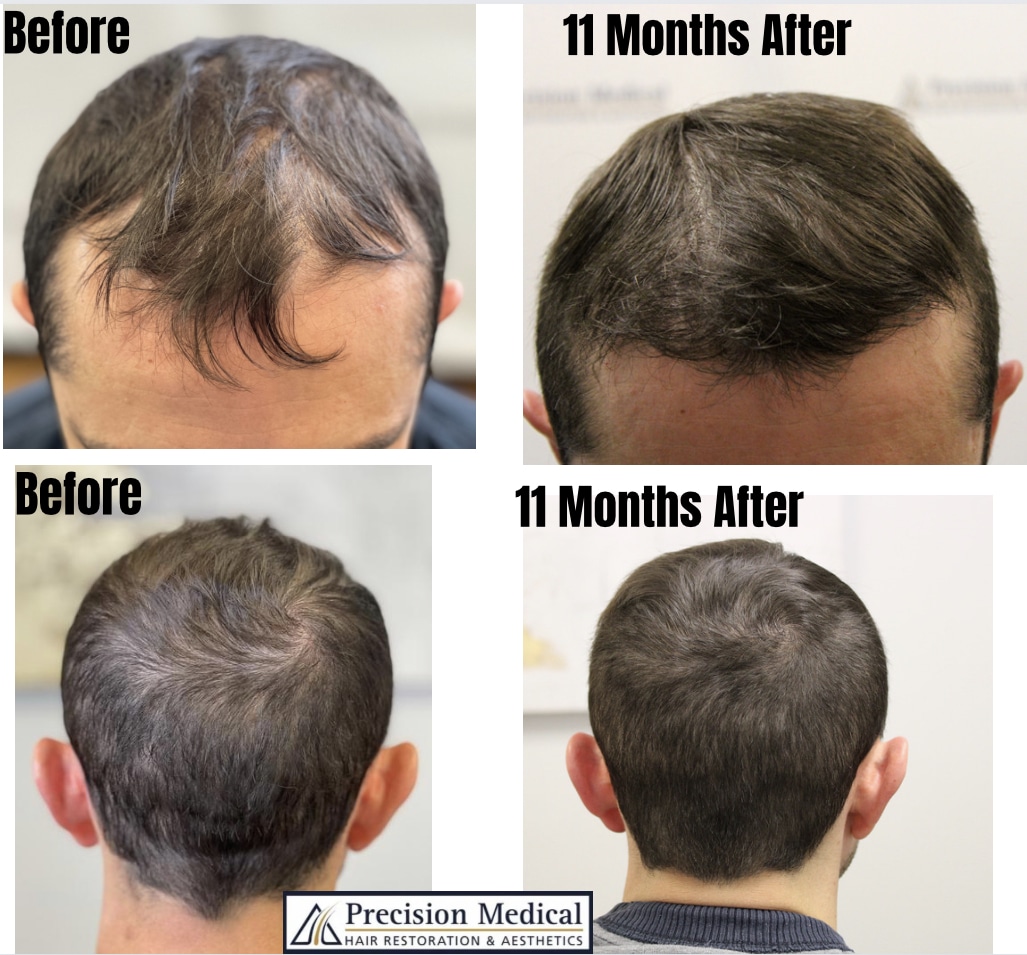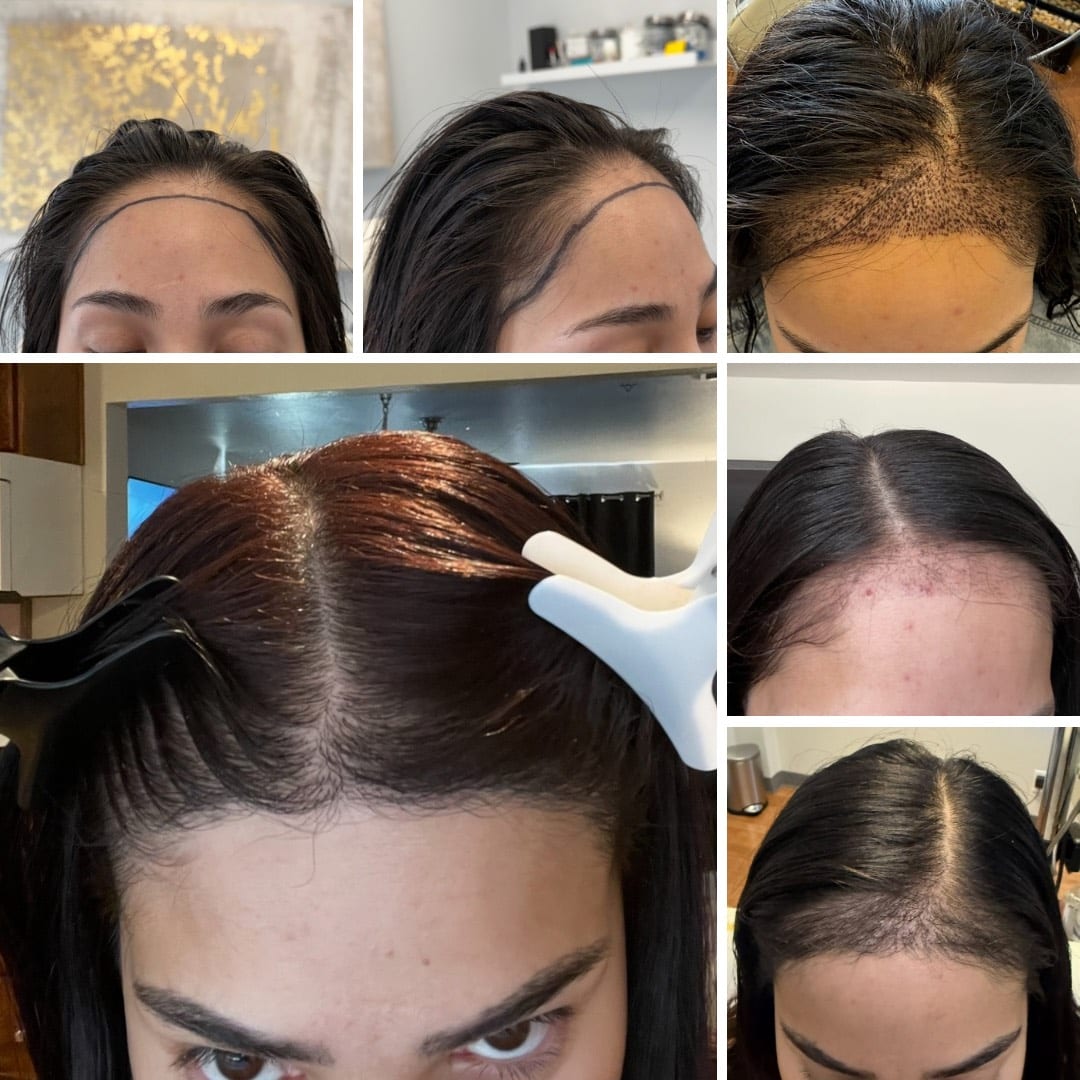
By Precision Medical Hair Restoration & Aesthetics
At Precision Medical Hair Restoration & Aesthetics in Albuquerque, we believe an informed patient is a confident patient. If you’re considering or already scheduled for a hair transplant, understanding what recovery looks like can help ease anxiety and set realistic expectations. Here’s a week-by-week breakdown of what most patients experience after a follicular unit extraction (FUE) procedure.
Week 1: Healing Begins
The first few days after your transplant are all about rest and healing.
What to expect:
- Swelling around the forehead and eyes (typically resolves within 5 to 7 days)
- Tiny scabs in the recipient and donor areas
- Mild soreness or numbness at the back of the scalp (donor site) or top of the scalp (recipient site)
Care instructions:
- Avoid touching or scratching your scalp
- Sleep with your head elevated to more quickly expedite resolution of swelling
- Sleep with a neck pillow for one week to prevent losing hair follicles from the recipient area on the pillow.
- Gently wash your hair starting Day 2, following the post-op instructions we provide
- Avoid strenuous activity, alcohol, and smoking
Week 2: Scabbing Resolves, Shedding Begins
By the end of the second week, most visible signs of surgery begin to fade.
What to expect:
- Scabs fall off naturally
- You may notice the transplanted hairs begin to shed — this is normal and part of the process
- Redness may persist in some patients, especially those with fair skin
- Native (non-transplanted) hairs begin growing
Care instructions:
- Continue gentle hair washing. We typically advise returning to the shower with gentle water pressure that is lukewarm beginning on post op day 10 to 12. At this point, you can gently lather the baby shampoo into the recipient area while using the pads of your fingers in a circular motion to help escort some of the cellular debris and scabs off the scalp. It may take 2 to 3 days with this technique for all the scabs to fall off on their own. We do not advise picking scabs off the scalp.
- Resume light exercise after Day 10 (activities like brisk walking, yoga, light body resistance). May begin to increase exertion with weightlifting and cardio at day 14 post op.
- Avoid excessive sun exposure! After a hair transplant, sun protection is crucial especially in the recipient area to prevent pigmentation changes, graft damage and prolonged redness.
- Most patients can wear a loose fitting baseball cap or hat 10 days after the procedure.
- May get a scissor haircut in the donor area after two weeks
Weeks 3–6: The “Invisible” Phase
The newly transplanted hair will shed almost completely by now — but don’t worry, the follicles are alive and well beneath the surface.
What to expect:
- Shedding is typically complete
- Your scalp may appear similar to how it did before the procedure although some fading redness may still be present.
- Hair growth is dormant, and you won’t see new growth just yet
- Some patients may experience lingering scalp numbness that is slowly improving
Care instructions:
- After 30 days you may wear sunscreen on your scalp using a mineral sunscreen such as zinc oxide or titanium dioxide
- Wait until 4-6 weeks before wearing a helmet or heavy headgear
- Be patient, this is the quiet stage before the real transformation begins
- You may use a shampoo and conditioner of your preference after 30 days
- Most patients can use Toppik hair fibers after 30 days. Make sure to apply gently and wash out daily to avoid buildup or folliculitis.
- After 30 days you can get a scissor haircut in both the donor and recipient areas.
Months 2–3: New Growth Begins
Tiny hairs will begin to emerge — often thin and wispy at first.
What to expect:
- Early hair growth starts, typically appearing around the 8- to 12-week mark
- Hairs may appear uneven, curly, or lighter in color at first
- Some patients experience minor acne-like bumps as new hairs push through. The frequency of and burden of these bumps tends to decrease with time.
Care instructions:
- You can begin using recommended hair growth treatments (like topical minoxidil or PRP therapy, if advised)
- Maintain a healthy diet and lifestyle to support hair health
- We recommend waiting at least 3 months before using clippers in the recipient area.
Months 4–6: Noticeable Progress
This is when excitement builds — the new hairs begin to thicken and mature.
What to expect:
- Hair grows in more densely
- Texture and color improve
- You’ll start to notice real changes in your hairline and volume
Months 6–12: Full Results Take Shape
At the one-year mark, most patients have achieved 80–90% of their final results.
What to expect:
- Continued thickening and growth
- Styling becomes easier
- Confidence grows along with your new hair
Beyond 12 Months: Final Touches
In some cases, final refinements and full density continue to develop up to 18 months post-transplant.
Ready to Begin Your Journey?
At Precision Medical Hair Restoration & Aesthetics, we’re with you every step of the way, from your initial consultation to full recovery and beyond. We tailor every procedure to your unique goals, ensuring natural results that last. Dr. Plaman is dedicated to his patients’ success long after the procedure is complete. He maintains regular contact in the days, weeks, and months following each hair transplant to closely monitor healing, provide personalized guidance, and answer any questions that arise. This attentive post-operative care helps patients feel supported, informed, and confident as they progress through their hair restoration journey. Dr. Plaman believes that great results come not only from surgical skill but also from a strong patient-doctor relationship throughout recovery. If you’re ready to take the next step toward restoring your confidence, schedule your consultation today!




